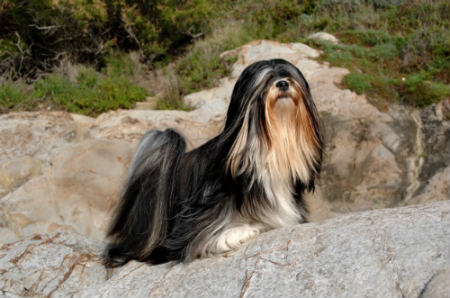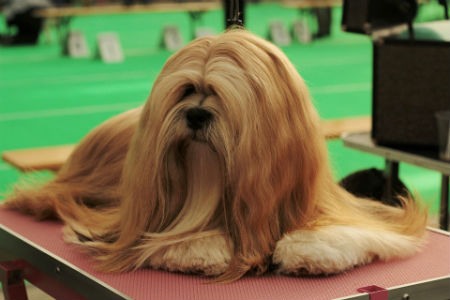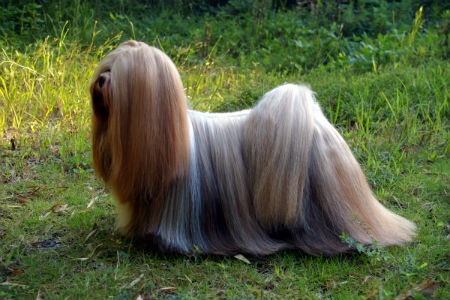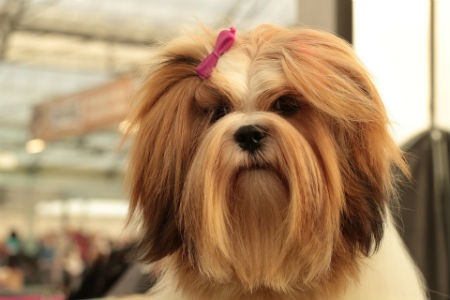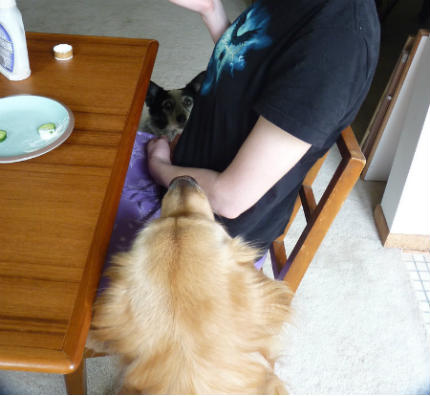The company of a pet is complemented with various benefits, both for the animal and for the person in charge of its care. Love, sweetness, friendship, joy and even protection are the attributes that a dog can offer. But, in addition, some races have special distinctive features. For example, the
Lhasa Apso is considered a symbol of luck in its city of origin.
-
Small size .
-
Weight : Between 5 and 8kg.
-
Hair type : Long and straight.
-
Character : Playful, Assertive, Intelligent, Firm, Devoted, Fearless, Friendly, Energetic, Vivacious, Alert, Obedient, Energetic
-
Health : Healthy
-
Life expectancy : Between 12 and 14 years.
Mysticism and independence is what characterizes this particular breed, because in addition to being considered a talisman in the Tibetan society where it was first known, it was adopted as an impetuous guard dog, despite its size. With a small body but great character and personality, since its recognition it has become one of the most exotic breeds in the world, not only because of its interesting history, but also because of how attractive it is as a companion animal. However, despite its independent behavior, this breed requires significant care if you want to extend its life exponentially. That is why this article will be dedicated to learning more about the historical, behavioral and care aspects related to this little furry friend.
History and origin
If it is about mysticism, the origin of the Lhasa Apso is undoubtedly covered in it. There are numerous theories that have been put forward regarding the history of this breed. Firstly,
its name is associated with the city where it was first known, Lhasa, in Tibet, whose creation was intended to protect the Tibetan temples, despite being a small race. In the monasteries of the aforementioned area, it was common to find a dog of this breed carrying out surveillance and protection tasks, because its barking warned of the presence of intruders. In fact, these places were guarded on the outside by mastiffs, while the inside was guarded by Lhasa Apsos.
In the beginning of the breed, in Tibet and other regions, it was known by the name
Apso Seng Kye , which translates as "lion sentinel dog", related to its furry appearance, similar to a diminutive lion. His relationship with the Tibetan terrier and other canines dedicated to herding was undeniable. However, the
International Cynological Federation (FCI) showed these breeds separately, making the Lhasa Apso official. In its city of origin, the popularity and mysticism of this animal transcended exponentially, to the point of being
considered a symbol of good luck capable of attracting prosperity and wealth to its owners. For this reason, on many occasions, specimens of these canines were granted to the leaders of foreign countries who visited Tibet, as a tribute. Its arrival in Europe was late, in the middle of the 20th century this animal crossed the borders of its native country. Because the Tibetans, considering it a sacred dog, wanted to keep it preserved. However, its popularity was growing. In Europe and other countries around the world, it is currently considered a companion and protection dog, ideal for outdoor activities such as hiking.
Physical characteristics of the Lhasa Apso
The Lhasa Apso can be a deceptive dog in relation to its appearance, because although it is a short animal, its body is robust and muscular, covered by
extraordinary and abundant fur , especially its head.
Let's see below the physical characteristics of this breed:
Size and weight
To date, the FCI has not established a standard height and weight for this breed, so a slight variation in this aspect has normally been seen between the breed. However, the average size for these dogs is 25 centimeters for males, while females measure a little less (22 centimeters). Regarding weight, they can reach 7 to 8.5 kilograms, regardless of their sex. Some may slightly exceed these measurements.
head and face
A
predominant physical aspect of the Lhasa Apso is the head, because it is abundantly covered by its fur, similar to that of a lion, which makes it appear as if it had a large skull. But it's not like that. Its skull is small and round. His eyes are black, oval in shape, not very big. The nose is the color of his eyes, and small. While its ears, triangular and tiny, fall back slightly and are not easily observed as they are covered by the hair that covers its entire frontal space.
Contexture
The body of the Lhasa Apso breed is small but very well formed, longer than tall. This is covered by two thick layers of its extensive fur. Its legs are short proportional to the body, but well planted, they facilitate mobility with great dexterity.
Line
It is set high and falls thinly on your back. Like the rest of the body, it is covered by its extensive fur, with a very slight wave at the tip, which can only be observed up close.
Fur
The distinctive look of the Lhasa Apso is its coat . As mentioned in previous paragraphs, it is abundant throughout its body, with special prominence on its head, where it resembles a tiny lion. It is dense, thick and long. In its native country, the Lhasa Apso's coat was allowed to grow so that it spread over the ground. However, nowadays, it is common to find domestic specimens with shorter hair.
It also has two layers: the outer one, which protects it from the sun; and the even thicker interior allows you to stay warm during the cold season. The breed is accepted in different colors, from gold, through black, dark gray, white and brown, to shades such as sand or honey. It requires rigorous care and dedication, which is why the time available to dedicate to the maintenance of this breed must be considered.
Temper
It is a happy dog, although reserved in exaggerated displays of affection, and also very independent. In general,
the Lhasa Apso is not very sociable , distrustful of unknown people and jealous of the presence of other animals. However, this will change as you share life with them. In general, coexistence is not a problem if it is trained from an early age, with special emphasis on socialization. It is an intelligent and very skilled dog, so its education will not be a problem.
If we talk about space, this animal easily adapts to small places like apartments, but it also requires outdoor activities to stay emotionally balanced. Although they may seem cold, they enjoy sharing time and games with their owners. However, you should not be excessive in
pampering them, as they tend to get upset easily. We must also remember that this is a breed that was originally used as a guard, so this ability is deeply rooted in the behavior of the Lhasa Apso. Because of this, it is normal for him to bark as a warning when faced with a situation that he considers suspicious or unusual, and he will stop doing so when he sees that everything is now under control. In a place with children, it can be calm, as it is loyal to its owners and very protective, however it must always be kept under surveillance when playing with the little ones.
Training the Lhasa Apso
The education of the Lhasa Apso is elementary, because it is an independent dog that can be considered an “alpha” in the family.
Training these pets is not complicated . We are talking about an intelligent and attentive dog, so it will be very easy to teach him commands if you start at an early age. It must be taken into account that the training process must begin with socialization. It is essential that the dog, as a puppy, acquires practice in relation to this topic, if you want it to be able to coexist easily with other people and pets, without being aggressive or distrustful. Educating him will allow him to be a balanced animal and behave well both at home and in other places. We must not forget the importance of positive reinforcement. The dog will respond obediently and attentively to commands if it is rewarded during training and treated with kindness. The opposite will happen if we try to train it with shouts or violence, because it can become rebellious and the training will not be useless. After socialization, you can learn other commands that will be useful, and also tricks that can be very fun.
Health
In general, this breed enjoys good health and a lot of energy. Its longevity has become the longest, reaching almost 20 years of life. It is rarely affected by hereditary diseases, such as hip dysplasia. On the other hand, they can be affected by some skin diseases, especially if they do not receive adequate bathing and hygiene care for their coat. Kidney problems and the appearance of ulcers are other ailments that sometimes affect this breed, but none of them are usually common and they depend largely on the care they receive from their owners.
Lhasa Apso Care
We have reached one of the most important points of the article, and it is the care that must be taken into account if we want to adopt a Lhasa Apso dog. It is important to reiterate that
this breed requires numerous care that must be rigorously followed if its beauty and good health are to be preserved. Let's see the most basic ones below:
Hygiene
An essential aspect in the maintenance of this breed is hygiene, especially brushing. The Lhasa Apso
requires its coat to be brushed at least once a day to avoid the appearance of knots that could damage its dense coat. Delicacy when performing this procedure is important, otherwise your hair may break. It should be moistened a little to prevent breakage and a soft comb or brush should be used. It is recommended to use a high-quality special conditioner for dogs, so that the shine and silkiness of their coat can be maintained. Bath time is the best time to brush, as the hair is wet and thus we avoid the appearance of knots. Regarding bathing, it should be done at least twice a month.
Feeding
Almost as important as hygiene is the Lhasa Apso's diet, as it is directly linked to the maintenance of its coat and also its overall health. Firstly, providing quality feed, with an adequate amount of nutrients and also that promotes the shine of its coat, is essential for this breed to remain well cared for. On the other hand, feeding in small proportions, twice a day, will be enough to keep our little friend satisfied. The excessive use of snacks or rewards is not recommended, because it can cause obesity in the dog.
Exercises
This breed does not require an intense exercise routine. With a daily walk you can stay calm. It adapts to any space, so it won't be a problem if you live in an apartment or in the country.
Vaccination and deworming
Maintaining adequate control of vaccines, deworming and check-ups with the veterinarian is also of utmost importance. Well, in this way, you will receive the necessary medical care and remain free of diseases.
Conclusion
In short, the Lhasa Apso dog is not a breed intended for everyone. Only those who really have enough time to properly care for this dog can enjoy its company. An eccentric and loyal animal is what defines these
specimens of small size but great energy and beauty. A dog full of skills, ideal for hiking and as a companion dog, can be a great friend. Consider if it is the pet you need and, above all, if you have the time to dedicate to taking care of its health and enjoying its company.
Items we recommend:
